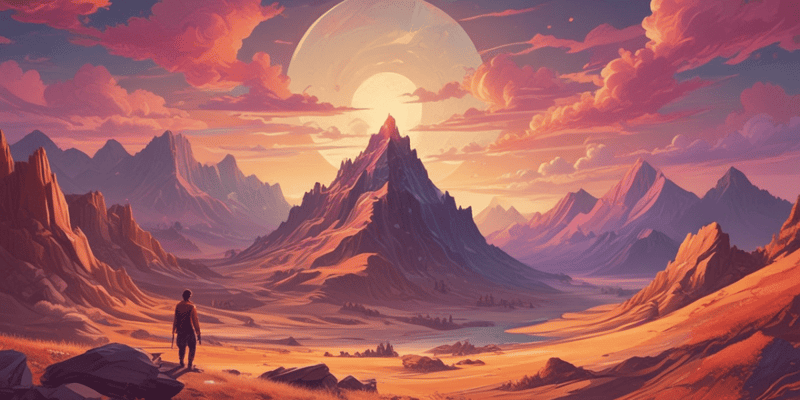Podcast
Questions and Answers
What type of shapes did Riley study and use in her art?
What type of shapes did Riley study and use in her art?
When did Riley begin to introduce color into her work?
When did Riley begin to introduce color into her work?
What series did Riley create when she began using color in her work?
What series did Riley create when she began using color in her work?
What technique did Riley use in 'Cataract 3' to produce the illusion of movement?
What technique did Riley use in 'Cataract 3' to produce the illusion of movement?
Signup and view all the answers
Who is considered one of the originators of Op Art?
Who is considered one of the originators of Op Art?
Signup and view all the answers
What did neuroscientist Donald M. MacKay create in 1957 that influenced Op Art?
What did neuroscientist Donald M. MacKay create in 1957 that influenced Op Art?
Signup and view all the answers
How did Op Art challenge the viewer's visual acuity?
How did Op Art challenge the viewer's visual acuity?
Signup and view all the answers
What did Victor Vasarely experiment with before moving to geometric abstraction?
What did Victor Vasarely experiment with before moving to geometric abstraction?
Signup and view all the answers
What defined and created the illusional positive space and negative areas in Op Art?
What defined and created the illusional positive space and negative areas in Op Art?
Signup and view all the answers
Who is a prominent figure in the Op Art movement?
Who is a prominent figure in the Op Art movement?
Signup and view all the answers
What did Victor Vasarely use to create the illusion of movement in his 'Supernovae' paintings?
What did Victor Vasarely use to create the illusion of movement in his 'Supernovae' paintings?
Signup and view all the answers
What type of patterns does Bridget Riley's work often feature?
What type of patterns does Bridget Riley's work often feature?
Signup and view all the answers
In what way did Vasarely create three-dimensional images on a two-dimensional platform?
In what way did Vasarely create three-dimensional images on a two-dimensional platform?
Signup and view all the answers
How did Op Art influence other industries?
How did Op Art influence other industries?
Signup and view all the answers
Study Notes
- Op Art involves the use of optical illusions, kinetics, and geometric abstraction to create the illusion of movement in static artwork.
- Victor Vasarely (1906-1997), a Hungarian artist, is a key figure in the Op Art movement. He studied art after medical school and moved to Paris to work as a graphic designer.
- Vasarely's work includes a series of black and white paintings called "Supernovae," where he used a grid of white lines to create the illusion of shifting shapes and movement. He believed that the perception of motion was achieved through the aggressive way the geometric structures appear to the retina.
- Bridget Riley (1931-), a British artist, is another prominent figure in Op Art. She studied art after World War II and experimented with various styles before developing her signature style of geometric patterns with optical illusions.
- Riley's work, such as "Metamorphosis," often features circles with varying gray tones to create the illusion of movement. She traveled extensively and was inspired by the bright colors and patterns of Egypt and India.
- Op Art became a significant part of the 1960s culture, and its patterns and illusions were used extensively in the fashion and design industries.
- Vasarely developed a methodology of using a set of colors and creating lines and shapes for his color system, which he called his 'artistic alphabet.' He created 1,161 black squares inside the grid of thin white lines in "Supernovae," which appear to shift and move based on the viewer's perception.
- Riley's work often includes geometric shapes placed in curves to add movement and optical variances. She thought of her work as inspired by the dynamism of visual forces, not in realistic forms.
- Vasarely used a two-dimensional platform to create three-dimensional images by reducing or expanding the grid sections, transforming squares and circles into rhombuses and ellipses. His work, such as "Vega-gyongly-2," appears as a rotating ball in the middle of a flat grid, with additional movement created by white squares chased throughout the painting.
Studying That Suits You
Use AI to generate personalized quizzes and flashcards to suit your learning preferences.
Description
Test your knowledge about Op Art, the art style that plays with optical illusions and visual effects to challenge the viewer's perception. Explore the history, key figures, and iconic artworks of this influential movement.




